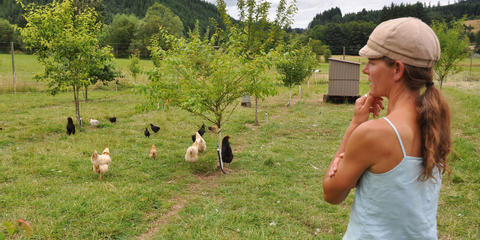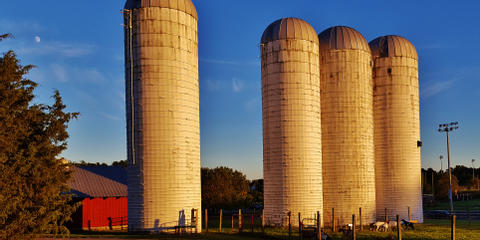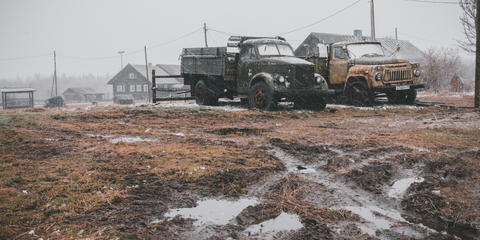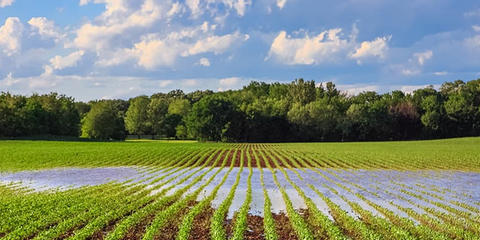Did you suffer crop quality losses due to natural disasters that occurred in 2018 or 2019? USDA is implementing the Quality Loss Adjustment (QLA) Program to provide financial assistance to crop producers who experienced quality losses caused by qualifying disaster events.
USDA announced on January 5, 2021 that the Quality Loss Adjustment Program will assist producers whose eligible crops suffered quality losses due to qualifying drought, excessive moisture, flooding, hurricanes, snowstorms, tornadoes, typhoons, volcanic activity, or wildfires occurring in calendar years 2018 and/or 2019. QLA joins a suite of USDA programs offering disaster assistance for America’s farmers.
Eligibility
Eligible Crops
Crops that can be covered by federal crop insurance or the Noninsured Crop Disaster Assistance Program (NAP) are generally considered eligible for QLA, excluding the below crops deemed ineligible.
To be eligible for the program, a crop must have:
suffered a quality loss due to a qualifying disaster event and
had a five-percent-or-greater quality discount due to the qualifying disaster event.
Eligible crops may have been sold, fed on-farm to livestock, or may be in storage at the time of application.
Ineligible Crops
Crops that were destroyed before harvest are not eligible for QLA.
The following crops are also ineligible:
grazed crops,
honey,
maple sap,
aquaculture,
floriculture,
mushrooms, ginseng root,
ornamental nursery,
sea grass and sea oats,
Christmas trees, and
turfgrass sod.
Eligible producers include individuals or legal entities who are:
entitled to an ownership share and
at-risk in the agricultural production and marketing of crops on the farm.
To be eligible for payments, a person or legal entity must either:
have an average adjusted gross income (AGI) of less than $900,000 for tax years 2018 and 2019 or
derive at least 75 percent of their AGI from farming, ranching, or forestry-related activities.
Persons and legal entities also must:
have control of the crop acreage on which the commodity was grown at the time of the disaster;
comply with the provisions of the “Highly Erodible Land and Wetland Conservation” regulations, often called the conservation compliance provisions;
not have a controlled substance violation; and
be a citizen of the United States or a resident alien. All entities consisting of more than one person must solely include United States citizens or resident aliens.
Assistance through QLA is available for eligible crops that suffered quality loss due to one or more of the following disaster events. The disaster event must have occurred in calendar year 2018 or 2019.
Tornado
Typhoon
Volcanic activity
Snowstorm
Wildfire
Hurricane
Flood
Excessive moisture
Qualifying drought
For drought, producers are considered eligible if the loss occurred in an area within a county rated by the U.S. Drought Monitor as having a D3 (extreme drought) or higher intensity level during 2018 or 2019.
Generally, the crop quality loss must have occurred in a county that received a qualifying Presidential Emergency Disaster Declaration **or **Secretarial Disaster Designation because of one or more of these qualifying disaster events or a condition caused by these events.
Producers in counties that did not receive a qualifying disaster declaration or designation may still apply for QLA with supporting documentation showing that the crop quality loss was directly affected by a qualifying event. For example, supporting documentation might include weather data from a reputable source.
Terms
Payment Calculations
QLA payments will be calculated based on the type of crop – forage or non-forage – and the type of documentation submitted by the producer as shown below.
Forage Crops with Documentation of Nutrient Factors for Affected Production and Historical Nutrient Factors
For forage crops with verifiable documentation of nutrient factors for the affected production for the year of application and the three preceding crop years, the following payment equation will be used.
QLA Payment = Total Affected Production x Verifiable % Loss x Average Market Price x 0.7
The average market price is determined by USDA’s Farm Service Agency, and the producer’s verifiable percentage of loss is determined by comparing the nutrient factor test results for the affected production to the average from the three preceding crop years.
Forage Crops with Documentation of Nutrient Factors for Affected Production Without Historical Nutrient Factors
For forage crops with verifiable documentation of nutrient factors for the affected production for the year of application but no historical nutrient factors for the three preceding crop years, the following payment equation will be used.
QLA Payment = Total Affected Production x County Average % Loss x Average Market Price x 0.7 x 0.5
The average market price is determined by USDA’s Farm Service Agency.
Non-Forage Crops with Documentation of Grading Factors Due to Quality and Dollar Value Loss Due to Quality
For non-forage crops with verifiable documentation of grading factors and the total dollar value loss due to quality, the following payment equation will be used.
QLA Payment = Total Dollar Value Loss on Affected Production x 0.7
Non-Forage Crops Without Dollar Value Loss Due to Quality but With Documentation of Grading Factors Due to Quality
For non-forage crops without verifiable documentation of the total dollar value loss, but with verifiable documentation of grading factors, the following payment equation will be used:
QLA Payment = Total Affected Production x County Average Loss Per Unit of Measure x 0.7 x 0.5
To determine the county average percentage of loss for forage crops or the county average loss per unit of measure for non-forage crops, FSA will calculate the average loss for a crop based on the losses of producers applying with verifiable documentation of historical nutritional factors for forage crops, or the total dollar value loss for non-forage crops if at least five eligible producers in the county submitted that documentation.
Payment Limitations
For each crop year, 2018 and/or 2019, the maximum payment that a person or legal entity may receive, directly or indirectly, is $125,000.
Payments made to a joint operation, including a general partnership or joint venture, will not exceed the total of $125,000 multiplied by the number of persons and legal entities included in the ownership of the joint operation.
Application Instructions
To apply, producers must submit a completed program application along with supporting documentation. Producers can apply directly through their local USDA Service Center or via our online QLA Application Portal.
Submit Application to USDA Service Center
Producers can download, fill out, and submit the below forms to the FSA office at their local USDA Service Center.
A complete QLA application will include:
FSA-898, Quality Loss Adjustment Program Application
Download FSA-898 and Instructions
Download FSA-898 Continuation Sheet and Instructions
FSA-899, Historical Nutritional Value Weighted Average Worksheet (if applicable) Note: FSA-899 is applicable for forage crops with verifiable documentation of historical nutrient factors from the three preceding crop years.
Download FSA-899 and Instructions
Download FSA-899 Continuation Sheet and Instructions
FSA–895, Crop Insurance and/or NAP Coverage Agreement
- Download FSA-895 and Instructions
FSA-578, Report of Acreage
Verifiable documentation of the quality loss
Apply Online via Portal
Producers with an eAuthentication account can apply for QLA via our QLA Application Portal. Applications are completed, electronically signed, and submitted directly to your local Service Center through this online system. Producers interested in creating an eAuthentication account should visit farmers.gov/sign-in to learn more.
Note: Online applications cannot be created for entities such as corporations, limited partnerships, limited liability companies, trusts, or estates via the QLA Application Portal. QLA applications for these business types should be initiated by contacting your local USDA Service Center or the call center at 877-508-8364.
Additional Forms
The below forms must be submitted for each crop year within 60 days of the date you sign the QLA application. If you are an existing customer with FSA, this information may already be on file at your local USDA Service Center.
AD–1026, Highly Erodible Land Conservation (HELC) and Wetland Conservation (WC) Certification
CCC–902, Farm Operating Plan for Payment Eligibility
CCC-941, Average Adjusted Gross Income (AGI) Certification and Consent to Disclosure of Tax Information
CCC-942, Certification of Income from Farming, Ranching and Forestry Operations (if applicable)
QLA payments will not be made until all necessary eligibility documentation is received by the FSA office at your local USDA Service Center.
Required Documentation
In addition to application materials, producers must submit dated documentation showing quality loss and quantity of affected production.
Examples of acceptable documentation include:
sales receipts from buyers,
settlement sheets,
truck or warehouse scale tickets,
written sales contracts,
records that represent actual and specific quality loss information, and
forage tests for nutritional values.
Verifiable documentation for grain crops that were sold may come from any time between harvest and sale of the affected production, unless the FSA county committee determines the record is not representative of the condition within 30 days of harvest. For all other crops, verifiable documentation must come from tests or analyses completed within 30 days of harvest, unless the FSA county committee determines that the record is representative of the condition of the affected production at time of harvest.
For forage crops, producers must submit verifiable documentation showing the nutritional value for the affected production. Producers must also submit verifiable documentation of the historical nutritional value for the three preceding crop years, if available.
For non-forage crops, producers must submit verifiable documentation of the total dollar value loss due to quality, if available, and verifiable documentation of grading factors due to quality.
If requested by FSA, an applicant must provide documentation that establishes the quality loss and applicant's ownership share and value at-risk in the crop.
Forms
CCC-902
Resources
Related Programs

Direct Farm Operating Loan
Farm Service Agency
- Loan
- General
- Equipment
- Animal Purchase
- Diversification
- Marketing
- Processing
- Feed
- Seed
- Fertilizer
- Cash Rent
- Housing
- Construction
- Infrastructure
- Repairs
- Pest Management
- Storage
- Legal & Finance
- Water Management
- Waterway Protection
- Water Quality
- Conservation
- Training
- Immigrants
- CSA
- Refinancing
- Reduced Tillage
- National
- Any

Environmental Quality Incentives Program (EQIP)
Natural Resources Conservation Service
- Grant
- Cost Share
- Conservation
- Cover Crops
- Forest Management
- Certified Grassfed
- Irrigation
- High Tunnel
- Certified Organic
- Air Quality
- Alternative Energy
- Soil Health
- Wildlife & Pollinator Habitat
- Water Quality
- Weather
- Research
- Landscape
- Precision Ag
- Drought
- Nutrient Management
- Carbon Capture
- Fencing
- Agroforestry
- Grazing Management
- Reduced Inputs
- National
- Any

Farm Storage Facility Loan Program (FSFL)
Farm Service Agency
- Loan
- Infrastructure
- Equipment
- Storage
- Lighting
- Delivery Vehicle
- National
- Oilseeds
- Peanuts
- Pulse Crops
- Hay
- Honey
- Biomass
- Fruits
- Vegetables
- Floriculture
- Hops
- Maple Sap
- Milk
- Cheese
- Yogurt
- Butter
- Eggs
- Rye
- Aquaculture
- Poultry
- Livestock
- Grains

Inflation Reduction Act Assistance for Distressed Borrowers
Farm Service Agency
- Grant
- Discount
- Socially Disadvantaged
- Disaster Relief
- National
- Any
Details
Release Date
January 6, 2021
Deadline
April 9, 2021
Organization
Financial Instrument
Grant
Updated March 22, 2024
Image Credit: USDA
This information was gathered from public sources. Ambrook is not responsible for or able to affect the results of any financial programs listed, nor are they responsible for any incorrect information that is listed or is on the hyperlinked external sites. All information is subject to change.
Explore hundreds more programs on Ambrook.
